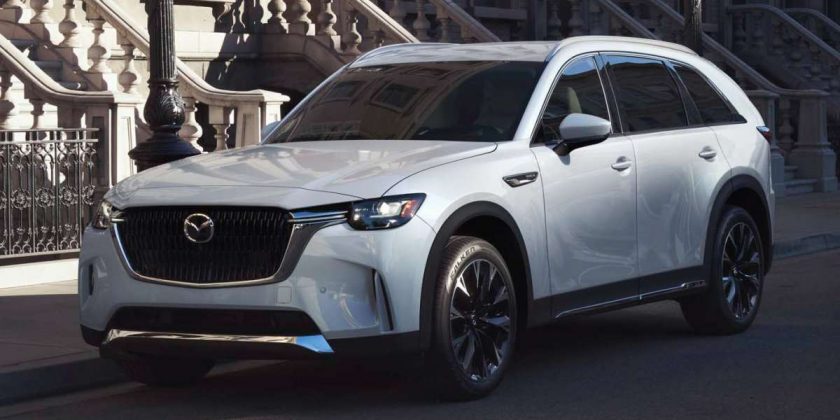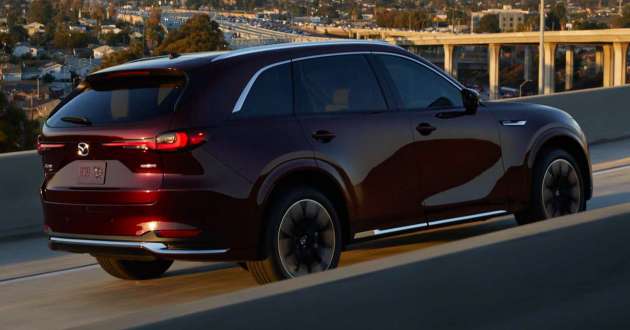Here it is, the all-new Mazda CX-90. The three-row SUV is the latest to join the carmaker’s Large Product group that includes the two-row CX-60, with the CX-70 and CX-80 set to arrive later this year. The CX-90 will replace the CX-9 as the brand’s flagship in the United States when it goes on sale this spring, with Australia also set to receive the model.
The CX-90 is Mazda further setting its sights on the premium SUV segment, and just like the CX-60, it rides on the brand’s Skyactiv Multi-Solution Scalable Architecture with a front-engine longitudinal layout and rear-wheel drive.
For the US market, the CX-90 will be offered with two electrified powertrains. The first is an e-Skyactiv G 3.3 litre turbocharged six-cylinder petrol engine with a 48-volt mild hybrid system (M Hybrid Boost) that delivers 345 PS (340 hp or 254 kW) and 500 Nm of torque, which is more than what the CX-60 with the same engine can muster.
The M Hybrid Boost system features an electric motor that is sandwiched between the engine and eight-speed automatic transmission, the latter being a little unconventional as it uses a multi-plate wet clutch setup instead of a torque converter, just like how Mercedes-Benz does it.
Joining the mild hybrid option is a plug-in hybrid system that has a total system output of 327 PS (323 hp or 241 kW) and 500 Nm of torque. These figures are identical to the CX-60, and the e-Skyactiv PHEV powertrain consists of a Skyactiv-G 2.5 litre naturally-aspirated four-cylinder petrol engine, an electric motor and a 17.8-kWh lithium-ion battery. Given its larger size, the CX-90 should offer an all-electric range less than the CX-60’s 60 km.
Both powertrains come with i-Activ all-wheel drive as standard, with Mazda is eager to point out that the system is rear-biased. There’s also Mazda Intelligent Drive Select (Mi-Drive) that offers four distinct driving modes (Normal, Sport, Off-road and Towing), with the PHEV variant gaining further options to manage its powertrain. Last but not least, the MX-5’s Kinematic Posture Control is included in the CX-90 to help minimise vehicle body roll and enhance cornering stability.
In terms of design, the CX-90 appears to be a larger version of the CX-60, featuring a long bonnet and dash-to-axle ratio that clearly indicate the SUV’s rear-wheel drive proportions. The front end also sports a large, vertical grille with similar detailing and is linked by light bars to the small headlamps. One notable difference is the shape of the air curtains at the bottom corners of the bumper, with the CX-90 getting a more subtle look aligned vertically.
As for the rear, the CX-90 gets the CX-60’s familiar L-shaped taillight signature but has its exhaust outlet tucked away behind some chrome trim. The need to ensure there’s space for the third row also means the rear window isn’t as steeply raked. Wheel sizes go up to 21 inches and Artisan Red (a Takuminuri colour) will be offered to customers.
Further similarities to the CX-60 can be seen inside the cabin, where the CX-90 has a nearly identical dashboard layout with its smaller sibling, also sharing the same steering wheel and gear knob design. The SUV comes in three seating configurations for either six, seven or eight passengers, with the six-seater boasting second-row captain chairs.
The materials used are befitting of the CX-90’s premium ambitions, with Nappa leather upholstery, wood and tone-on-tone fabrics used to elevate the cabin. Available tech features include a digital instrument cluster, an infotainment screen sized at either 10.25 or 12.3 inches, three-zone automatic climate control with all-row air vents, ambient lighting, USB-C charging ports (including for the third row) and a See-Through View monitor.
Mazda’s i-Activsense systems are also standard and include Smart Brake Support (autonomous emergency braking), Blind Spot Monitoring and Mazda Radar Cruise Control. Pricing and further details will be announced later, but the CX-90 is expected to retail for between USD40,000 and USD60,000 (RM170,632 and RM255,948). That’s more than the CX-9 that ranges from USD38,750 to USD48,460 (RM165,300 to RM206,721).
Source: Read Full Article




